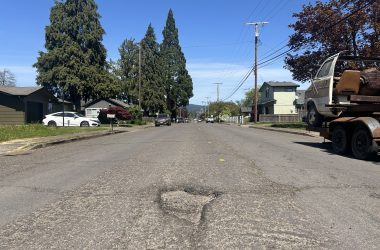 The searchers, having just retrieved the bodies of the three trappers from Lava Lake, prepare them for transportation to Bend, in April 1924. Image provided/Deschutes Pioneer Gazette
The searchers, having just retrieved the bodies of the three trappers from Lava Lake, prepare them for transportation to Bend, in April 1924. Image provided/Deschutes Pioneer Gazette
BY THE TIME THE ICE over Lava Lake melted in the spring of 1924, no one had any illusions about what they would find underneath it.
Trappers Edward Nickols, Dewey Morris and Roy Wilson had disappeared from their cabin sometime around the middle of January, leaving their clothes, guns and bedrolls behind. When relatives arrived in early April to look for them, they found blood and spent gun cartridge shells in the snow, and a sled trail leading out into the middle of Lava Lake – ending at a spot where someone had chopped a hole in the ice with an ax.
It didn’t take a Sherlock Holmes to figure out what those clues added up to … and it didn’t take a Nostradamus to predict what they’d find floating in Lava Lake when the ice melted.
When it finally did, police got out in boats to look for the three corpses. They soon found them, tied lines around them and towed them to the boat landing.
The bodies had most definitely been murdered.
Nickols had been hit with a shotgun blast at close range, which had torn away part of his face and chest. Wilson had also been shotgunned, in the right shoulder and subsequently shot with a pistol behind the ear. And someone had gone berserk with a blunt instrument on Morris’ face.
Police already had a suspect in the killings: Charles Kimzey, an escaped convict from Idaho who had been Nickols’ partner the previous winter. He had sworn to get revenge on Nickols after Nickols put the police on his trail.
But they knew, from evidence at the scene, that the killer hadn’t worked alone. That much was obvious just looking at the body of former U.S. Marine Roy Wilson.
Wilson had been hit in the shoulder with a shotgun; then, later, someone had managed to get close enough to him to shoot him in the head with a pistol. It seemed pretty unlikely that anyone could have done that without help.
Of all the various categories American citizens can be assigned to, if ”wounded Marine” isn’t the the most dangerous, it’s certainly in the top five.
The Portland furrier who’d bought the fox furs stolen from the murdered trappers definitely remembered two men.
One had been quiet and taciturn; the other, garrulous and friendly. The friendly one had chatted volubly about trapping, the wilderness, Bend and various other things – clearly trying to charm the furrier.
The other had looked a lot like Kimzey, but looking at the mugshot, the furrier couldn’t be sure; the man he’d seen had dropped the furs and left, saying nothing and doing nothing to call attention to himself.
Had it been Kimzey? Maybe. Everyone involved with the case was sure it had been. But, without proof ….
KIMZEY WAS FINALLY CAUGHT in Kalispell, Mont., in 1932, eight years after the murders, when one of his former jailers recognized him on the street.
Immediately after his arrest, he raised eyebrows by saying, ”They think I killed those trappers, but I didn’t, I was in Colorado working on the Moffatt Tunnel at the time.”
The alibi was a little shaky, and Kimzey was so ready with it that authorities were pretty sure he’d fabricated it after figuring out he’d need it. They figured they could break it if they dug into it deep enough; but they also figured it wasn’t worth bothering with, because the evidence of Kimzey’s guilt was all circumstantial. They really didn’t think they could nail him on it.
He knew it, too. So when they brought him in, he figured he’d come out of it all okay. He was probably a lot more worried they’d extradite him to Idaho, where he was wanted for breaking out of prison during a 15-year sentence for burglary.
But they knew something he didn’t. A year or so before the Lava Lake murders, Kimzey had hired a car to drive him to Idaho. Halfway there, apparently while stopped in the middle of nowhere for a ”call of nature,” Kimzey had clobbered the driver, W.O. Harrison, knocking him out. Then he’d bound him hand and foot with bailing wire and thrown him down a nearby abandoned well, obviously expecting him to die there; and drove on in the stolen car.
But Harrison did not die. He woke up, untangled his wrists from the wire, climbed out of the well, and found his way to a ranch – ironically, it was the Last Chance Ranch – to get help.
Harrison was able to positively identify Kimzey as the man who had tried to kill him. And attempted murder was a pretty beefy charge. It wouldn’t send Kimzey to the gallows, but it could put him away for life, and as far as Deschutes County Sheriff Claude McCauley was concerned, that was much better than nothing.
”Utah wanted Kimzey for murder” – another largely circumstantial case, involving another hired-car driver, in 1925 – ”and Idaho wanted him back on an escape charge,” McCauley recalled nine years later, ”but I decided he’d be safer in Oregon. We still had the attempted murder charge hanging over him, and I accordingly sent for W. O. Harrison.”
McCauley doesn’t recount the effect it had on Kimzey when Harrison’s name was first mentioned and his would-be killer realized he’d survived to testify against him – but it was probably deeply satisfying to the outraged lawman.
Kimzey pleaded not guilty, of course. No one was in any mood to offer him any kind of plea deal.
”Harrison easily identified Kimzey as the man who had so nearly murdered him,” the sheriff recalled. ”The jury found Kimzey guilty as charged after three hours of deliberations. Two days later Circuit Judge T. E. Duffy sentenced Kimzey to life imprisonment in the Oregon State Penitentiary.”
And so the Lava Lake triple homicide remains officially unsolved to this day, although almost everyone involved was sure the man who did it got put safely away. The judge was certainly sure of it; life sentences are very seldom handed down for attempted murder.
A decade or two later, Kimzey would use the extended sentence as his main argument for early release to the parole board.
Eventually, in 1957, roughly 25 years into his sentence and now in his early 70s, Kimzey was paroled out of the joint. He promptly decamped for Idaho, where he lived out the rest of his life without further incident.
THE QUESTION REMAINS, though … who was Kimzey’s accomplice? Who was the glib, smooth-talking man who chatted up the Portland furrier while negotiating the sale of the stolen (and mishandled) fox pelts? Who was the unknown ”social engineer” who somehow lured Nickols, Morris, and Wilson out of their log cabin almost completely unarmed so that Kimzey could wreak his vengeance upon them?
Remember, they knew who Kimzey was and they were expecting trouble from him. They were not expecting trouble from whoever knocked on their cabin door that fateful day, and, except for Wilson with his Luger, they left their weapons in the cabin when they followed him out … which strongly argues that they didn’t know trouble was afoot until they were standing in the open and lead was in the air.
Author Melany Tupper makes the case that the accomplice was none other than Ray Van Buren Jackson, Central Oregon’s ”angel of death” – Jackson was one of Kimzey’s associates, and Jackson appears with chilling regularity on the periphery of about a dozen unsolved homicide cases in Central Oregon throughout the first three decades of the 1900s.
And Jackson was exactly the kind of glib, easy talker described by the furrier, and the kind of guy who could sell the three trappers a story that would lead them out of their safe, fortress-like log cabin to their deaths.
But, in the final analysis, nobody really knows. And it’s extremely unlikely that anyone ever will.
Sources: ”Grisly 1924 Lava Lake murders still ‘unsolved,’” an article by Jim Crowell published on May 31, 2012, in the Deschutes Pioneers’ Gazette; The Trapper Murders, a book by Melany Tupper published in 2013 by Central Oregon Books; archives of the Portland Morning Oregonian for April and May 1924
Finn J.D. John teaches at Oregon State University and writes about odd tidbits of Oregon history. His book, Heroes and Rascals of Old Oregon, was recently published by Ouragan House Publishers. To contact him or suggest a topic: [email protected] or 541-357-2222.








